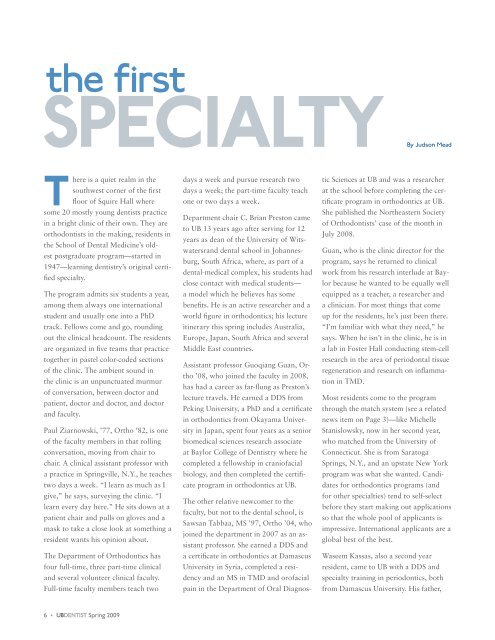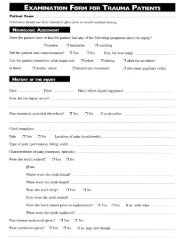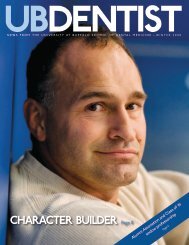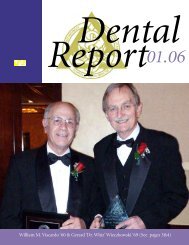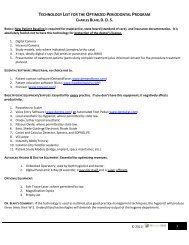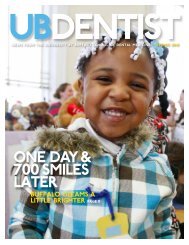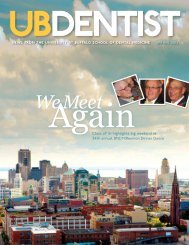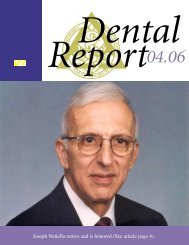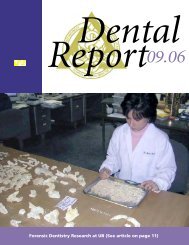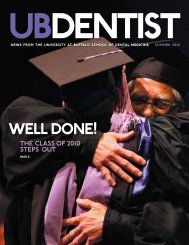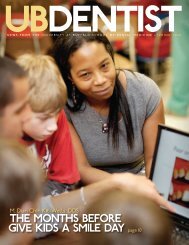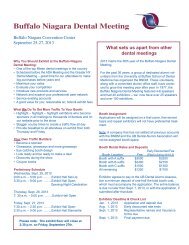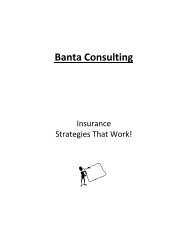You also want an ePaper? Increase the reach of your titles
YUMPU automatically turns print PDFs into web optimized ePapers that Google loves.
the first<br />
specialty<br />
there is a quiet realm in the<br />
southwest corner of the first<br />
floor of Squire Hall where<br />
some 20 mostly young dentists practice<br />
in a bright clinic of their own. They are<br />
orthodontists in the making, residents in<br />
the School of <strong>Dental</strong> Medicine’s oldest<br />
postgraduate program—started in<br />
1947—learning dentistry’s original certified<br />
specialty.<br />
The program admits six students a year,<br />
among them always one international<br />
student and usually one into a PhD<br />
track. Fellows come and go, rounding<br />
out the clinical headcount. The residents<br />
are organized in five teams that practice<br />
together in pastel color-coded sections<br />
of the clinic. The ambient sound in<br />
the clinic is an unpunctuated murmur<br />
of conversation, between doctor and<br />
patient, doctor and doctor, and doctor<br />
and faculty.<br />
Paul Ziarnowski, ’77, Ortho ’82, is one<br />
of the faculty members in that rolling<br />
conversation, moving from chair to<br />
chair. A clinical assistant professor with<br />
a practice in Springville, N.Y., he teaches<br />
two days a week. “I learn as much as I<br />
give,” he says, surveying the clinic. “I<br />
learn every day here.” He sits down at a<br />
patient chair and pulls on gloves and a<br />
mask to take a close look at something a<br />
resident wants his opinion about.<br />
The Department of Orthodontics has<br />
four full-time, three part-time clinical<br />
and several volunteer clinical faculty.<br />
Full-time faculty members teach two<br />
6 u <strong><strong>UB</strong>Dentist</strong> spring 2009<br />
days a week and pursue research two<br />
days a week; the part-time faculty teach<br />
one or two days a week.<br />
Department chair C. Brian Preston came<br />
to <strong>UB</strong> 13 years ago after serving for 12<br />
years as dean of the University of Witswatersrand<br />
dental school in Johannesburg,<br />
South Africa, where, as part of a<br />
dental-medical complex, his students had<br />
close contact with medical students—<br />
a model which he believes has some<br />
benefits. He is an active researcher and a<br />
world figure in orthodontics; his lecture<br />
itinerary this spring includes Australia,<br />
Europe, Japan, South Africa and several<br />
Middle East countries.<br />
Assistant professor Guoqiang Guan, Ortho<br />
’08, who joined the faculty in 2008,<br />
has had a career as far-flung as Preston’s<br />
lecture travels. He earned a DDS from<br />
Peking University, a PhD and a certificate<br />
in orthodontics from Okayama University<br />
in Japan, spent four years as a senior<br />
biomedical sciences research associate<br />
at Baylor College of Dentistry where he<br />
completed a fellowship in craniofacial<br />
biology, and then completed the certificate<br />
program in orthodontics at <strong>UB</strong>.<br />
The other relative newcomer to the<br />
faculty, but not to the dental school, is<br />
Sawsan Tabbaa, MS ’97, Ortho ’04, who<br />
joined the department in 2007 as an assistant<br />
professor. She earned a DDS and<br />
a certificate in orthodontics at Damascus<br />
University in Syria, completed a residency<br />
and an MS in TMD and orofacial<br />
pain in the Department of Oral Diagnos-<br />
by Judson mead<br />
tic Sciences at <strong>UB</strong> and was a researcher<br />
at the school before completing the certificate<br />
program in orthodontics at <strong>UB</strong>.<br />
She published the Northeastern Society<br />
of Orthodontists’ case of the month in<br />
July 2008.<br />
Guan, who is the clinic director for the<br />
program, says he returned to clinical<br />
work from his research interlude at Baylor<br />
because he wanted to be equally well<br />
equipped as a teacher, a researcher and<br />
a clinician. For most things that come<br />
up for the residents, he’s just been there.<br />
“I’m familiar with what they need,” he<br />
says. When he isn’t in the clinic, he is in<br />
a lab in Foster Hall conducting stem-cell<br />
research in the area of periodontal tissue<br />
regeneration and research on inflammation<br />
in TMD.<br />
Most residents come to the program<br />
through the match system (see a related<br />
news item on Page 3)—like Michelle<br />
Stanislowsky, now in her second year,<br />
who matched from the University of<br />
Connecticut. She is from Saratoga<br />
Springs, N.Y., and an upstate New York<br />
program was what she wanted. Candidates<br />
for orthodontics programs (and<br />
for other specialties) tend to self-select<br />
before they start making out applications<br />
so that the whole pool of applicants is<br />
impressive. International applicants are a<br />
global best of the best.<br />
Waseem Kassas, also a second year<br />
resident, came to <strong>UB</strong> with a DDS and<br />
specialty training in periodontics, both<br />
from Damascus University. His father,


